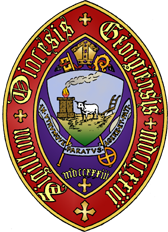After lengthy spiritual discernment and theological debate, the Episcopal Church approved of women’s ordination to the priesthood in 1976. It would be nine years before the first woman was ordained in the Diocese of Georgia.
 Bishop Paul Reeves was clear in his opposition to women’s ordination, “this action needs to be seen as but one manifestation of what appears to be a widespread breakdown of sound doctrine and discipline in the Church.” During this time several clergy of the diocese, troubled by the ordination of women, accepted the Pastoral Provision offered by Pope John Paul II in 1980, which allowed for married Episcopal priests to be re-ordained Roman Catholic priests. Three Georgia diocesan priests accepted the offer. Bishop Reeves was supportive of their decision.
Bishop Paul Reeves was clear in his opposition to women’s ordination, “this action needs to be seen as but one manifestation of what appears to be a widespread breakdown of sound doctrine and discipline in the Church.” During this time several clergy of the diocese, troubled by the ordination of women, accepted the Pastoral Provision offered by Pope John Paul II in 1980, which allowed for married Episcopal priests to be re-ordained Roman Catholic priests. Three Georgia diocesan priests accepted the offer. Bishop Reeves was supportive of their decision.
In his final sermon as bishop in 1985, Bishop Reeves said he had served in a, “long and frequently upsetting period of Prayer Book revision; and during this same era we saw our small part of the Anglican Communion opt to go its own reckless way, and change the accepted discipline of nearly two millennia, and say that women could be ordained to the priesthood. These three events occurred during a time of social, economic, political and moral upheaval in our own country and in the world generally. I know of no one who is competent – and I know I am not – to make a final judgment on these phenomena, whether in the long run of history they will be seen to have been positive, or negative, or merely incidental and transitory.”
At the time of his election in 1985, Bishop Harry Shipps was opposed to the ordination of women to the priesthood, especially on grounds of impairment of ecumenical relations with the Roman Catholic Church. In the course of his episcopate Bishop Shipps instituted a listening process with clergy conferences to gauge diocesan reaction to possible ordination of women to the priesthood as permitted by 1976 General Convention. Strong division on both sides of the issue existed. In addition to other opportunities for dialogue the bishop brought the Presiding Bishop, The Most Rev. Edmund L. Browning, to meet in St. Michael’s, Savannah, for open discussion on the issue with clergy and laity of the diocese.
 Early dissent to the ordination of women organized into a group called The Traditionalist Clergy of the Diocese of Georgia. Approximately a dozen diocesan priests attended meetings in Dublin, supported by Bishop Paul Reeves, who came from his retirement home in North Carolina. Bishop Shipps attended several gatherings to explain his positions. The ordination issue led to a split in the congregation of St. John’s in Moultrie, resulting in formation of the congregation of St. Margaret of Scotland.
Early dissent to the ordination of women organized into a group called The Traditionalist Clergy of the Diocese of Georgia. Approximately a dozen diocesan priests attended meetings in Dublin, supported by Bishop Paul Reeves, who came from his retirement home in North Carolina. Bishop Shipps attended several gatherings to explain his positions. The ordination issue led to a split in the congregation of St. John’s in Moultrie, resulting in formation of the congregation of St. Margaret of Scotland.
Marking a change in his previous position, Bishop Shipps initiated the process leading to ordination of women in both orders. Susan Harrison of Savannah was admitted to the process for vocational diaconate and ordained in September 1985. Sonia Sullivan of Valdosta was accepted for priesthood and attended seminary. At the Sullivan ordination in 1993 at Good Shepherd in Swainsboro, a large contingent of women priests from the Diocese of Atlanta were present in support.
In the 30 years since that ordination, Bishop Henry Louttit and Bishop Scott Benhase ordained 28 women as deacons (vocational) and 42 women to the Sacred Order of Priests. Bishop Frank Logue has ordained one woman to the diaconate and two women to the priesthood. Many more ordained women have faithfully served in the Diocese of Georgia, serving, so far, in every leadership role in the Diocese except bishop.
 Pictured: (top) a newspaper article on the Rev. Sonia Sullivan Clifton’s ordination, (middle) Bishop Shipps is pictured above with the clergy of the Diocese at a diocesan convention, and (bottom) Bishop Logue with clergy at the 2022 diocesan convention.
Note: This article was edited from Bishop Shipps’ reflections on his episcopacy with an update added to the end of the article above.
Pictured: (top) a newspaper article on the Rev. Sonia Sullivan Clifton’s ordination, (middle) Bishop Shipps is pictured above with the clergy of the Diocese at a diocesan convention, and (bottom) Bishop Logue with clergy at the 2022 diocesan convention.
Note: This article was edited from Bishop Shipps’ reflections on his episcopacy with an update added to the end of the article above.
